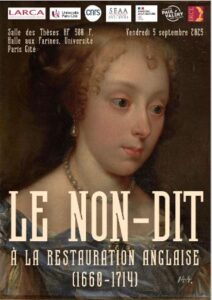Call for papers
Things Unsaid, Things Unwritten
during the English Restoration (1660-1714)
Joint conference IRCL (Université Paul-Valéry Montpellier 3) – LARCA (Université Paris Cité)
With the support of the Société d’Études Anglo-Américaines des XVIIe et XVIIIe siècles (SEAA 17-18)
Keynote lecture: Dr. Rosamund Oates, Manchester Metropolitan University
Conference date: 5th September 2025
Location: Bâtiment Halle aux Farines, Université Paris Cité, Paris, France.

At once both familiar and paradoxical, the expressions ‘unsaid’ and ‘unwritten’ challenge the supposed dichotomy between speech and silence. Both terms suggest an absence, a lack (of words) that stubbornly bears the trace of a presence, at least for those able to decipher it. The expressions ‘unsaid’ and ‘unwritten’ constitute an invitation to understand, to guess, to give birth (as the expression ‘pregnant silence’ suggests) to a meaning that will not, or cannot, be explicitly said. They may also bear witness to an erasure, a potential site for resistance, for defiance. How are we to identify the signs of a silence that are not silences at all? And how are we to understand and reconstruct this absent discourse?
There is a renewed interest in gesture and its meanings in the mid-17th century, for example, exemplified by the work of the physician John Bulwer. Inspired by Spanish precedents and quickly imitated in turn, Bulwer creates a silent language he considers superior to speech: with Chirologia and Chironomia (1644), he invents a “manual rhetoric” he conceives not as an impeded form of language, but rather as one that transcends speech to convey higher truths – “Sic manus alloquitur hominem sic deum” (“thus the hand addresses man and therefore God”) says the frontispiece. Only later does this language become that of the deaf and mute: Bulwer first intended his creation for the pulpit and the stage.
While these alternative systems of signification are not specific to theatre, ‘things unsaid’ take on a particular resonance in the context of theatre. On stage as in life, speech is but one way of creating meaning: the actor’s entire body is invested, and may compete with or even replace verbal expression entirely when speech proves insufficient. Non-verbal (sets, stage directions, gestures, music, sound effects) and para-verbal (interjections, shouts) signifiers articulate the dialectics of speech and silence.
In cultural representations more broadly, silence can operate as a sign of female virtue, denoting chastity, modesty and compliance – a tradition which the Restoration perpetuates. Yet this silence is also often tied with violence. The number of scenes featuring sexual violence synchronises markedly with the rise of the presence of actresses onstage after 1660. Violence is generally committed off-stage, and lack of appropriate consent is often signified non-verbally through the victim’s appearance and her distressed silence. Such tableaux evoke the then nameless notions of sideration, catatonia, and traumatic mutism, furthered explored in eighteenth-century novels. ‘Things unsaid’ thus may constitute simultaneously a trace of trauma and a site of resistance.
Like a trace perceptible only to the initiated, what remains ‘unsaid’ or ‘unwritten’ may also be configured in terms of plausible deniability. How choices may be understood and by whom is particularly crucial to marginalised groups and individuals. A prudent, coded rhetoric of unspoken desires thus develops in the space between speech and silence: desires that are forbidden or illegal, whose subjects or objects are deemed unworthy, inappropriate or monstrous; desires out of wedlock; non-heteronormative desires. The history of the margins is a story of silenced desires that nevertheless find coded expressions that stubbornly leave traces underneath the dominant discourse.
The issue of what is ‘left unsaid’ (or unwritten) also has echoes in religious matters during the Restoration. The fractured religious landscape, torn between the pressures of conformity, non-conformity and recusancy, the back-and-forth between repression of non-Anglican faiths and attempts at tolerance, gives rise to various negotiations between displaying and hiding one’s true faith. In turn, this raises the question of the relationship between the private and public spheres, between what is ostensibly shown and what is discreetly signified.
More generally, over the second half of the seventeenth century, rhetorical strategies of suggestion (metaphor, synecdoche, allusion, irony, etc.) play an essential role against a still active apparatus of censorship. However, the relative freedom awarded by the suspension of the Licensing Act also paradoxically fosters self-imposed forms of censorship: studies of the traces of such acts of self-monitoring, for example, would constitute welcome contributions to this conference.
This conference particularly encourages proposals addressing the following questions:
- Gestures and non-verbal communication during the Restoration;
- Asides, sound effects, shouts, cries, sets design, non-verbal and para-verbal signs that make up the semantic layers of a performance;
- Silent characters, monologues, silent or non-verbal reactions in the theatre;
- History of mute and/or deaf people, of non-verbal forms of communication;
- Style and the rhetoric of plausible deniability;
- Book history, manuscripts bearing traces of suppressed passages;
- Strategies to avoid censorship and the question of self-censorship;
- Coded and non-verbal expressions of forbidden desires, in particular in connection with queer identities and practices;
- Traumatic mutism and its representations;
- Representations of female silence and its potential for resistance;
- Visual and artistic culture mixing text and image (captions) or suggesting a silent discourse (such as “conversation pieces”);
- Material culture and the language of objects (clothes, decorative arts for example).
This project continues the conversation initiated in the conference “Consent, Refuse, Surrender: Shadows of Conquest during the English Restoration (1660-1714)”, held at the IRCL on 14th June 2024. These events are building for the future of an informal interdisciplinary research group on the Restoration.
Please send abstracts (300-500 words) along with biographies and bibliographies to the following address before the 31st January 2025: consentir.restauration@gmail.com
A large selection of papers will be published in the SEAA 17-18’s peer-reviewed journal XVII-XVIII by December 2025. Style guidelines are available here.
Scientific committee:
Prof. Charles-Édouard LEVILLAIN, LARCA, Université Paris-Cité
Prof. Frédéric OGÉE, LARCA, Université Paris Cité
Prof. Florence MARCH, IRCL, Université Paul-Valéry Montpellier 3
Prof. Andrew HISCOCK, Bangor University-CNRS
Prof. Luc BOROT, IRCL, Université Paul-Valéry Montpellier 3
Dr Clara MANCO, LARCA, Université Paris Cité
Alice MARION-FERRAND, IRCL, Université Paul-Valéry Montpellier 3
Sara LEUNER, LARCA, Université Paris Cité
Indicative bibliography:
BAINES Barbara J., Representing Rape in the English Early Modern Period, Edwin Mellen Press, 2003.
BERGERON David M., “Silence in Shakespeare’s Comedies”, Essays in Criticism, 73, 3, 2023, 275-296.
BRAY Alan, “Homosexuality and the Signs of Male Friendship in Elizabethan England”, History Workshop, 29,1990,1-19.
CLARK Anna, Women’s Silence, Men’s Violence: Sexual Assault in England, 1770–1845, Pandora, 1987.
COCKAYNE, “Experiences of the deaf in early modern England”, The Historical Journal, 46, 3, 2003, 493-510.
COUSSEMENT Laëtitia et SUKIC Christine (éds.), “‘Silent Rhetoric’, ‘Dumb Eloquence’ : The Rhetoric of Silence in Early Modern Literature”, numéro spécial des Cahiers Charles V, 43, 2007.
CURELLY Laurent (ed.), special issue “Faire Silence”, XVII-XVIII, 73, 2016.
DOODY Margaret Anne, ‘Voices of Record: Women as Witnesses and Defendants in the Old Bailey Sessions Papers’, in Susan SAGE HEINSELMAN and Zipporah BATSHAW WISEMAN (éds.), Representing Women: Law, Literature and Feminism, Duke University Press, 1994.
DUGGAN Patrick, “Trauma and Drama/Theatre/Performance”, in The Routledge Companion to Literature and Trauma, Colin DAVIS et Hanna MERETOJA (éds.), Routledge, 2020.
FARR Jason S., “Libertine Sexuality and Queer-Crip Embodiment in Eighteenth-Century Britain”, Journal for Early Modern Cultural Studies, 16, 4, 2016, 96-11.
FARR Jason S., Novel Bodies: Disability and Sexuality in Eighteenth-Century British Literature, Bucknell University Press, 2019.
FUMAROLI Marc, L’École du silence: le sentiment des images au XVIIe siècle, Flammarion, 1994.
GREENFIELD Anne Leah (éd.), Interpreting Sexual Violence, 1660–1800, London: Routledge, 2014.
HOBGOOD Allison P. et HOUSTON WOOD David (éds.), Recovering Disability in Early Modern England, Ohio State University Press, 2013.
LUCKYJ, Christina, ‘A Moving Rhetoricke’: Gender and Silence in Early Modern England, 2002.
MACCUBBIN Robert Purks, ‘Tis Nature’s Fault: Unauthorized Sexuality during the Enlightenment, Cambridge University Press, 1988.
MILLER John, “The potential for ‘absolutism’ in later Stuart England”, History, 69, 226, 1984, 187-207.
OATES Rosamund, “Speaking in Hands: Early Modern Preaching and Signed Languages for the Deaf”, Past and Present, 256, 1, 2022, 49-85.
PATTERSON Annabel, Censorship and Interpretation, University of Wisconsin Press, 1984.
ROBERTSON Randy, Censorship and Conflict in Seventeenth-Century England: The Subtle Art of Division, Penn State University Press, 2009.
SHUGER Debora, Censorship and Cultural Sensibility: The Regulation of Language in Tudor-Stuart England, University of Pennsylvania Press, 2006.
THOMAS David, CARTLON David et ETIENNE Anne, “Theatre Censorship under the Royal Prerogative”, in Theatre Censorship: From Walpole to Wilson
TOMASELLI Sylvana et PORTER Roy; Rape: An Historical and Cultural Enquiry, Oxford, 1986.
WALKER Garthine, “Rape, Acquittal and Culpability in Popular Crime Reports in England, c.1670–c.1750″, Past & Present, 220, 1, 2013, 115-142.
WALLIS Mick, et DUGGAN Patrick, “Editorial: On Trauma”, Performance Research, 16, 1, 2011, 1‑3.
WILLIAMS Carolyn D., “‘Silence, like a Lucrece Knife’: Shakespeare and the Meanings of Rape”, The Yearbook of English Studies, 23, 1993, 93-110.
